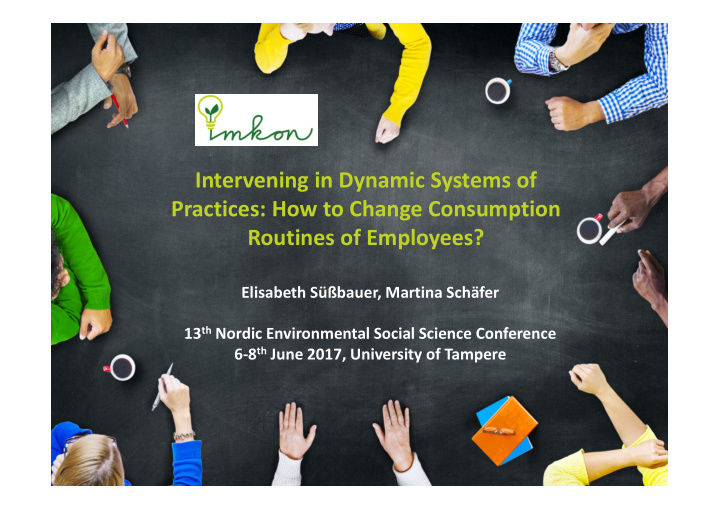



Intervening in Dynamic Systems of Practices: How to Change Consumption Routines of Employees? Elisabeth Süßbauer, Martina Schäfer 13 th Nordic Environmental Social Science Conference 6-8 th June 2017, University of Tampere
The IMKoN Project Integrating Employees as Consumers in the Management of Sustainable Innovations Products & Services Novel problem solutions meeting sustainability targets Sustainable Innovations Workplace & Work Environment and resulting in future-oriented consumer styles Occupational Role Private Role as Consumer Employee Participation 2
Research Question How to intervene in consumption practices at the workplace? Workplaces as enabling settings for sustainable consumption: • High degree of routinisation Energy saving Sustainable nutrition • Physically bounded in space and time • Intersecting domains and life Waste prevention Sustainable mobility spheres (work – home) 3
Research Design Case study companies in Germany (8) “Greening Goliaths” (3) “Growing Green Davids” (5) • washing and cleaning devices, washing and cleaning devices cosmetics • cosmetics, pharmaceutical products mail order mail order Sectors consumer goods and retail sales print and online media electricity supply Size 2.000 to 5.500 employees 60 to 900 employees Location urban, metropolitan rural, provincial
Research Design Methods applied in 2015/16 (amongst others): • Document analysis (e.g. sustainability reports) • 32 guided expert interviews with company management (from R&D, CSR, executive board) and works council • 7 focus group discussions with 5 to 10 employees (mixture of departments, positions, age and period of employment) 5
Theoretical Background Shove’s “stages in the life of a practice” 6
Results Framework for greening the workplace Source: Süßbauer & Schäfer, forthcoming 7
Results 1. Opportunity : providing materials, meaning and practical knowledge Goliaths companies: • Material conditions existing, but no common rules of conduct • Economically biased interpretation of sustainability • Low appreciation of “ordinary” employees as innovators David companies: strong sustainability (“an improvement for people, for nature”) 1. “Coherent” : organisation as a place for meaningful everyday behaviour, addressing all three elements at the same time, fostering informal learning, inclusion of ordinary employees 2. “Individual ”: organisation as a loose-knit bundle of practices and material arrangements, democratic leadership culture, high appreciation of private engagement, lack of practical knowledge transfer 3. “Functional” : organisation as a social system, clear hierarchies among management & employees, focus on formal training 8
Example Financial incentives: Equipment: Bike leasing Rental of ponchos, Bike repair grant for frequent cyclists bike trailer Personal bicycle helmet Infrastructure: Materials Roofed bike parking racks Showers Compressed air station Cycling to work Explicit: Formal: Practical Awarded by the German Repair workshop for Meaning knowledge Cyclist’s Association as women “Most Bicycle Friendly Annual bike check Business“ Informal: Implicit: Movie on Announcement of winner campaign at staff (teams) and saved CO2 meeting emissions Bike representative
Results 2. Experimentation: breaking old links and making new links Worked well Did not work well Addressing entire staff Test household approaches Multi-motivational approaches Focusing on single elements Team-based/ sharing approaches Individual approaches Use of digital tools Analogous organisation Based on employees’ needs Top down approaches Tailored to one specific practice Generic approaches (behaviour change campaigns) „Coherent“ type Other types? 10
Results 3. Stabilisation : strengthening links between elements and between practices • Recruitment of more carriers: – Long lasting and regular offers and measures – HRM practices for green work-life-balance, esp. for “burdened” groups • Linking practices from different life spheres: – “Work-to-life interventions” – “Life-to-work interventions” Work-life-balance is not linked with sustainable consumption Linking work and home practices often in “individualistic” workplaces No instruments for integrating ideas from private life of employees 11
Results Source: Süßbauer & Schäfer, forthcoming 12
Conclusions and Future Research Interventions in organisational contexts: • Meaning closely related to interpretations of the workplace (as functional system, loose-knit bundle of practices, place for meaningful behaviour) • Importance of appreciating and integrating employees’ needs foster feelings of agency at work • Important role of interactive formats (e.g. sharing, swapping) due to peer-to-peer learning stabilise/normalise sustainable consumption practices Future research on “systems of practices”: • Role of digital tools for intervening in intersectings of multiple practices • Differences between work and home routines e.g. way to work has different private meanings (time for relaxing, time for social networking, family time) analyse narrative interviews and cultural probes 13
www.imkon.de 14
Recommend
More recommend